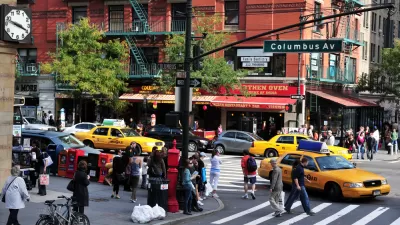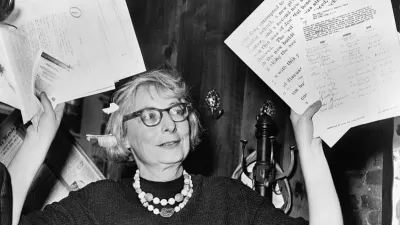Jane Jacobs, often viewed as the patron saint of the progressive urban planning world, maybe be given too much credit, according to this piece from Andrew Manshel.
"Her views have now been broadly adopted and it is conventional wisdom in planning circles that participatory neighborhood planning is best, that preservation of old buildings is essential, and that in cities the car is bad. But Jacobs had a tendency toward sweeping conclusions based on anecdotal information, and some of them were overblown and/or oblivious to the facts. Perhaps most graphically, Jacobs predicted that the grand arts center planned for the Upper West Side of Manhattan would fail. But Lincoln Center turned out to be a great success-igniting the revitalization of the entire neighborhood.
More revealingly, the Greenwich Village she held out as a model for city life has become some of the highest-priced real estate in New York City-it's no longer the diverse, yeasty enclave she treasured. Ultimately, many of the policies she advocated blocked real-estate development-causing prices of existing housing stock to rise and pricing out all but the wealthiest residents."
Manshel suggests that more attention be given to the ideas of William H. Whyte.
FULL STORY: Enough With Jane Jacobs Already

Manufactured Crisis: Losing the Nation’s Largest Source of Unsubsidized Affordable Housing
Manufactured housing communities have long been an affordable housing option for millions of people living in the U.S., but that affordability is disappearing rapidly. How did we get here?

Americans May Be Stuck — But Why?
Americans are moving a lot less than they once did, and that is a problem. While Yoni Applebaum, in his highly-publicized article Stuck, gets the reasons badly wrong, it's still important to ask: why are we moving so much less than before?

Research Shows More Roads = More Driving
A national study shows, once again, that increasing road supply induces additional vehicle travel, particularly over the long run.

Judge Halts Enforcement of Anti-Homeless Laws in Grants Pass
The Oregon city will be barred from enforcing two ordinances that prosecute unhoused residents until it increases capacity and accessibility at designated camping sites.

Advancing Sustainability in Los Angeles County Schools
The Los Angeles County Office of Education’s Green Schools Symposium brings together educators, students, and experts to advance sustainability in schools through innovative design, climate resilience strategies, and collaborative learning.

Using Old Oil and Gas Wells for Green Energy Storage
Penn State researchers have found that repurposing abandoned oil and gas wells for geothermal-assisted compressed-air energy storage can boost efficiency, reduce environmental risks, and support clean energy and job transitions.
Urban Design for Planners 1: Software Tools
This six-course series explores essential urban design concepts using open source software and equips planners with the tools they need to participate fully in the urban design process.
Planning for Universal Design
Learn the tools for implementing Universal Design in planning regulations.
City of Moreno Valley
Institute for Housing and Urban Development Studies (IHS)
City of Grandview
Harvard GSD Executive Education
NYU Wagner Graduate School of Public Service
City of Cambridge, Maryland
Newport County Development Council: Connect Greater Newport





























